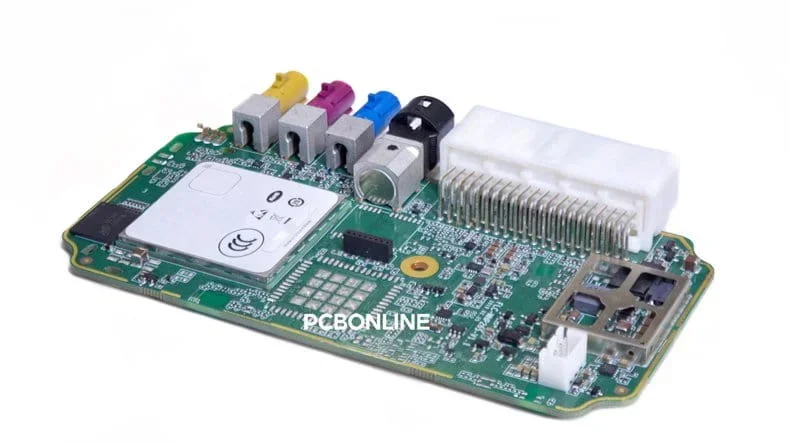
Have you ever wondered how the "things" in a network stay connected and communicate with each other to create the Internet of Things?
They require communication protocols. Just as humans use language, grammar, and vocabulary, connected devices rely on communication protocols like MQTT, HTTP, AMQP, CoAP, LoRaWAN, and many others.
In this blog, we will explore 4 different protocols that are used for IoT communications.
In this article:
Part 1: MQTT Part 2: CoAP Part 3: LoRaWAN Part 4: AMQP Part 5: Summary of the 4 IoT Protocols Part 6: One-Stop PCBA Manufacturer for IoT Projects — PCBONLINERegarding IoT solutions, no one protocol fits all use cases. Different protocols have been designed for different requirements such as device constraints, network conditions, and application needs.
Some are optimized for low power, while others provide scalability, reliability, or security. In this section, we will explore the top 4 IoT protocols with their use cases, importance, and working.
MQTT
Message Queuing Telemetry Transport (MQTT) is a lightweight machine-to-machine (M2M) messaging protocol that is now widely adapted for the Internet of Things.
MQTT operates on the Publish/subscribe model. It was originally developed by IBM in 1999 to connect oil pipelines via satellite, taking into account the limitations of low battery power and bandwidth.
It is highly efficient for constrained devices and networks with high latency. And it performs well in unreliable networks, which allow devices to communicate across the globe.
Working:
MQTT architecture has three components: the broker, client, and connection.
The Broker is the central part of the architecture and is responsible for receiving, filtering, and delivering messages to the correct destination. You can use cloud brokers such as HiveMQ and EMQX, or you can use Raspberry Pi to build your broker.
The MQTT client is any device that sends or receives data using the MQTT protocol. It can be a simple microcontroller, such as an Arduino or ESP32, or it can be your smartphone, laptop, or even a server.
The client and broker communicate through MQTT communication and TCP/IP stack.
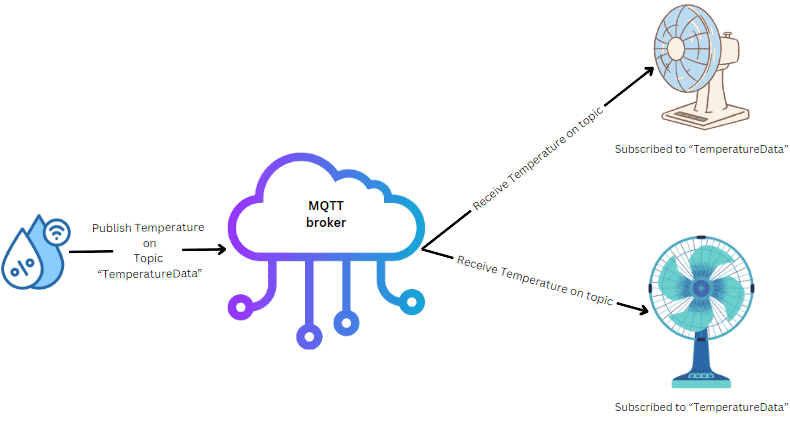
Fig: How does the MQTT protocol work?
MQTT works on a publish/subscribe model where devices communicate through a central broker. For instance, a temperature sensor can publish its readings to a topic like "TemperatureData," and devices like two fans can subscribe to that topic. Whenever the sensor sends new data, both fans receive the update simultaneously, allowing them to adjust their speed or turn on/off based on the temperature readings.
Use cases
It is used where the transfer of data is in real time over unreliable or constrained networks, such as
- Smart homes
- Industrial IoT
- Connected vehicles for real-time monitoring.
CoAP
Constrained Application Protocol or CoAP is a specialized web transfer protocol designed for use in resource-constrained environments and applications, primarily within the IoT.
It enables simple devices to communicate over the Internet while minimizing overhead. It is particularly effective for low-power devices and networks with high packet loss.
It uses User Datagram Protocol (UDP), which allows it to reduce latency conserve energy, and make it well-suited for applications like remote sensors and actuators in smart homes and industrial settings.
Working:
CoAP architecture consists of two primary components: Client and Server.
The CoAP server hosts resources (such as sensor data) and responds to requests from clients. It uses a request/response model similar to HTTP but is optimized for constrained networks.
A CoAP client can be any device that sends requests to the server or receives responses. This can range from simple microcontrollers, such as Arduino or ESP32, to more complex systems like gateways or smartphones.
Clients and servers communicate over the CoAP protocol, which operates on the UDP transport layer.
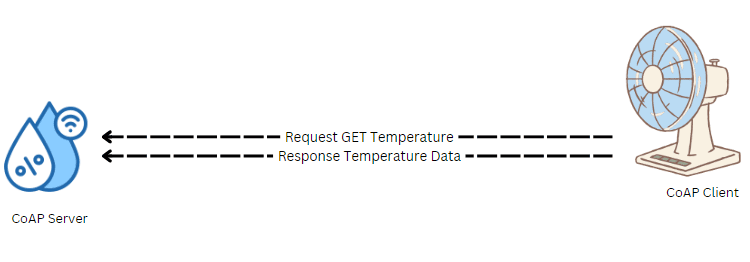
Fig: How does the CoAP protocol work?
CoAP utilizes a request/response model where a client can send a GET request to retrieve data from a server, such as a temperature reading. For example, a temperature sensor can be configured as a CoAP server that responds to GET requests from a client, providing real-time temperature data. This approach allows devices to interact efficiently while minimizing bandwidth usage.
Use cases
It is used where low-power devices require efficient communication over unreliable networks, such as,
- smart lighting
- environmental monitoring
- smart agriculture
LoRaWAN
Long Range Wide Area Network (LoRaWAN) is a low-power and wide-area networking protocol that requires long-range communication with minimal energy consumption.
It uses the LoRa (Long Range) modulation technique, enabling devices to connect over several kilometers while using very little power.
LoRaWAN was developed to address the challenges of connecting a large number of low-power devices spread across wide geographic areas. It is particularly effective in environments where traditional cellular or Wi-Fi networks are insufficient.
By operating in the unlicensed sub-GHz frequency bands, LoRaWAN facilitates cost-effective deployment for various IoT applications.
Working:
The LoRaWAN architecture consists of four primary components: End Devices, Gateways, Network Servers, and Application Servers.
- End Devices are the sensors or actuators that generate data or perform actions, such as temperature sensors, smart meters, or tracking devices. These devices use LoRa technology to transmit data to nearby gateways.
- Gateways act as intermediaries, receiving data from end devices and forwarding it to the network server. They are typically placed in strategic locations to maximize coverage and can connect multiple devices.
- Network Servers manage the network and process the data received from gateways. They handle device authentication, data routing, and the management of network resources.
- Application Servers receive processed data from the network server and provide services or insights to end-users through applications.
LoRaWAN operates on a star-of-stars topology, where end devices communicate with multiple gateways, ensuring redundancy and reliability.
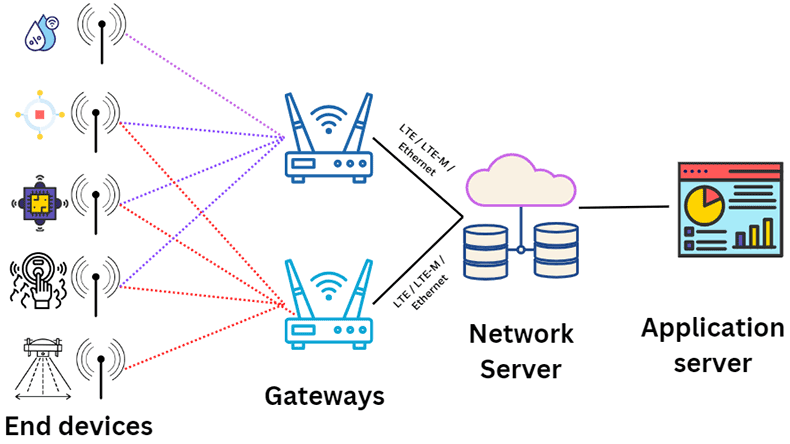
Fig: How does the LoRaWAN protocol work?
For example, a soil moisture sensor deployed in an agricultural field can send its readings to the nearest gateway, which then relays the data to the network server for further processing. This setup allows farmers to monitor soil conditions remotely, enabling timely irrigation decisions and optimizing resource usage.
Use cases
LoRaWAN is widely used where long-range communication and low-power operation are critical, such as:
- Smart agriculture
- Smart city
- Asset tracking
- Environmental monitoring
AMQP
Advanced Message Queuing Protocol or AMQP is a robust messaging protocol designed for high-performance and reliable messaging between applications.
It allows different systems to communicate asynchronously and ensures that messages are reliably delivered even in complex environments.
AMQP was developed to provide a standardized method for message-oriented middleware. Its architecture supports various messaging patterns, making it suitable for enterprise-level applications and services.
Working:
The AMQP architecture consists of three key components: Producer, Broker, and Consumer.
- The Producer is any application or device that sends messages to the broker. This could be a service generating data, such as an IoT device or a web application.
- The Broker acts as the intermediary responsible for receiving, storing, and routing messages to the appropriate consumers. It manages queues and ensures reliable delivery, handling message persistence and acknowledgment.
- The Consumer is the application or device that receives messages from the broker. It can be a service that processes incoming data or an IoT device that acts upon the received information.
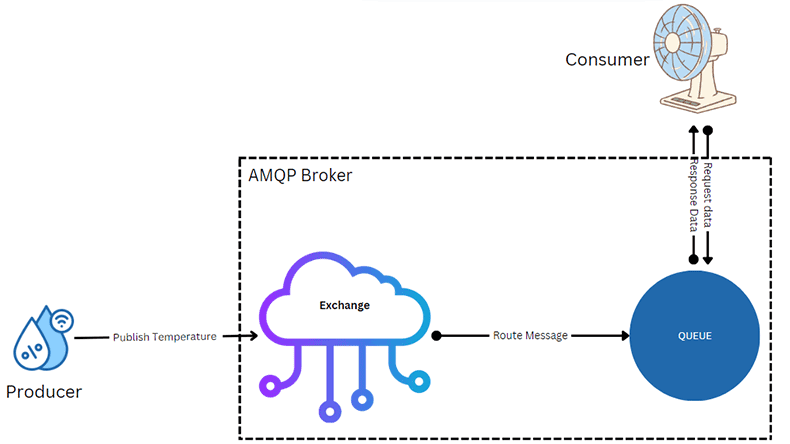
Fig: How does the AMQP protocol work?
AMQP operates on a publish/subscribe or point-to-point messaging model. For instance, a weather data producer can send updates to the broker, which stores the messages in a queue. Consumers, such as applications needing weather information, can retrieve these messages at their own pace. This asynchronous communication allows for scalability and flexibility in processing messages without overwhelming the sender.
Use cases
AMQP is commonly used where reliable and secure messaging is critical, such as
- Financial services
- Logistics
- Large-scale enterprise applications
Summary of the 4 IoT Protocols
The following table gives a summary of IoT protocols MQTT, CoAP, LoRaWAN, and AMQP.
|
IoT Protocol
|
Type
|
Data Transmission
|
Scalability
|
Security
|
Power Efficiency
|
|
MQTT
|
Pub/sub
|
Lightweight
|
⭐⭐⭐⭐
|
⭐⭐⭐
|
⭐⭐⭐⭐⭐
|
|
CoAP
|
Request/Response
|
Binary
|
⭐⭐⭐
|
⭐⭐
|
⭐⭐⭐⭐
|
|
LoRaWAN
|
star-of-stars
|
Low-Bandwidth
|
⭐⭐⭐⭐⭐
|
⭐⭐⭐
|
⭐⭐⭐⭐⭐
|
|
AMQP
|
Message Queuing
|
Reliable
|
⭐⭐⭐⭐
|
⭐⭐⭐⭐⭐
|
⭐⭐⭐
|
The above table shows that the MQTT protocol and LoRaWAN protocol get the most stars and both of them are very scalable, and power efficient and this is the reason why they are widely used. However, the AMQP protocol is highly secure and whenever a request/response model is required we can use the CoAP protocol.
One-Stop PCBA Manufacturer for IoT Projects — PCBONLINE
If you have completed the IoT project design and are looking for reliable manufacturers to bring your idea to reality, you can work with the one-stop printed circuit board assembly manufacturer PCBONLINE. It provides all electronics manufacturing and hardware building until the end products that have been inspected are delivered to you.

PCBONLINE provides turnkey IoT electronic manufacturing, including PCB fabrication, PCB assembly, component sourcing, testing, PCBA value-added, enclosures, and box-build assembly.
PCBONLINE offers free DFM (design for manufacturing) before and during prototyping to ensure success and smooth manufacturing for massive production.
Besides hardware building, PCBONLINE can do the R&D for all your IoT projects or take part in the development from the early development stage.
As a source factory manufacturer with two large advanced PCB manufacturing bases and one turnkey PCB assembly factory, PCBONLINE offers cost-effective manufacturing with transparency.
All the electronics manufacturing processes are traceable and certified with ISO 9001:2015, ISO 14001:2015, IATF 16949:2016, RoHS, REACH, UL, and IPC-A-610 Class 2/3.
PCBONLINE will offer you one-on-one engineering support throughout your IoT project no matter what quantity you require. To get a quote for one-stop electronics manufacturing for your IoT project, please contact info@pcbonline.com.
Conclusion
This blog introduces the four mainstream IoT protocols MQTT, CoAP, LoRaWAN, and AMQP, and compares them briefly. Whether you have finished the design for an IoT project or only have an initial idea yet, you can work with the one-stop IoT PCBA manufacturer PCBONLINE which offers both R&D and manufacturing.
Understanding these components is fundamental for engineers working in the IoT field. For the creation and manufacturing of robust and efficient IoT systems, work with the IoT PCBA manufacturer PCBONLINE for one-stop solutions.
PCB assembly at PCBONLINE.pdf




